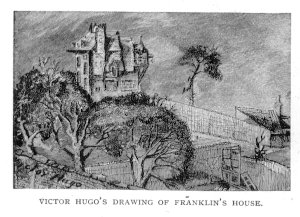Franklin and De Chaumont
Today, Ben Franklin, revolution, and a house in Paris. The University of Houston's College of Engineering presents this series about the machines that make our civilization run, and the people whose ingenuity created them.
How utterly interwoven were the revolutions of the late 18th century! There was really only one revolution. Our American Colonies, the French, the British, and all of Europe rose up in different ways to bring down the old aristocracies. The process was oddly unified, yet it was laced with ironies. For example:
By the time we signed our Declaration of Independence, a clockmaker named Caron de Beaumarchais had found his way into the French aristocracy. Seven years later, Beaumarchais would write the revolutionary play, The Marriage of Figaro and give Mozart the basis for his lovely, and equally revolutionary, opera. But now, in 1776, Beaumarchais signed a receipt for a million livres from the new French king, Louis XVI. He was to disburse it in support of the American Revolution. In other words, a commoner-turned-aristocrat, but still a revolutionary, took money from the monarchy to support a rebellion.
The Colonies got word of the support as they were preparing to send 70-year-old Ben Franklin to Paris to secure French help, and it was good news indeed. The Americans were walking into a political snake pit, but shrewd old Ben Franklin was well-connected on the Continent. His work on electricity had established him as a popular scientist of the first rank.
The French put Franklin in the hands of an aristocrat named de Chaumont, who strongly supported the Colonial cause. De Chaumont offered Franklin the large guesthouse on his grand estate. He also became his conduit into high-level politics.
Franklin was an instant cult figure in France, with a kind of Elvis Presley popularity. That stemmed from many things. He fed the current French mania for experimental science. The French called him The Electric Ambassador. And politically, he didn't just represent the coming revolution in France, he embodied it.
Franklin, aging and infirm, came home just before Revolution swept over France. Our wealthy supporters didn't see it coming. King Louis was eventually beheaded. De Chaumont lost his estate. His son went to New York to manage a land investment on the route of a canal. (It was being surveyed by the great engineer Marc Brunel -- a French royalist who fled to America) Canal traffic would've made a fortune for the younger de Chaumont, but the Erie Canal pre-empted him with a different trade route. So he settled into his land, became an American landowner, and a president of the New York State Agricultural Society.
 De Chaumont's Paris guesthouse no longer stands, but we know what it looked like because Victor Hugo, whose writings were laced with Franklin's ideals about social equality, made quite a detailed sketch of it. No revolution is simple. And the 18th century gave us a tapestry of interwoven revolutions. But Ben Franklin was a red thread that runs through every inch of the fabric of that epoch in the reclamation of human rights.
De Chaumont's Paris guesthouse no longer stands, but we know what it looked like because Victor Hugo, whose writings were laced with Franklin's ideals about social equality, made quite a detailed sketch of it. No revolution is simple. And the 18th century gave us a tapestry of interwoven revolutions. But Ben Franklin was a red thread that runs through every inch of the fabric of that epoch in the reclamation of human rights.
I'm John Lienhard, at the University of Houston, where we're interested in the way inventive minds work.
(Theme music)
Bigelow, J. Franklin's Home and Host in France. The Century Magazine, Vol. 35, No. 5, March, 1888, pp. 741-754.
Schama, S., Citizens: A Chronicle of the French Revolution, New York: Vintage Books, 1989.
For more on Franklin see also the Encyclopaedia Britannica article, see Episodes 141, 510, 710, 1377, 1386, or click on the Search Episodes button below to find additional material on Franklin.